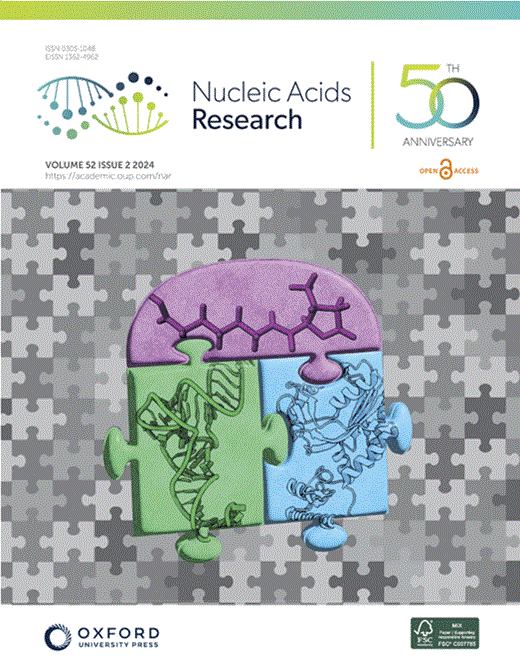RegRNA 3.0:扩展调控RNA分析与motif,相互作用和注释的新功能。
IF 16.6
2区 生物学
Q1 BIOCHEMISTRY & MOLECULAR BIOLOGY
引用次数: 0
摘要
功能性RNA分子在从基因调控到蛋白质合成的生物过程中至关重要,分析功能基序和元件对于理解RNA调控至关重要。在RegRNA 1.0和2.0的基础上,我们提出了RegRNA 3.0,这是一个复杂的元工作流,集成了26个计算工具和28个数据库进行注释,实现了一步和可定制的RNA基序预测。RegRNA简化了多步骤分析,并通过交互式可视化和综合报告工具增强了结果解释。当提供RNA序列时,RegRNA 3.0生成RNA功能基序、RNA相互作用基序和综合RNA注释的预测。具体来说,RNA功能基序包括核心启动子元件、RNA衰变、g -四重体和之前的14种类型。RNA相互作用基序包括新增加的RNA-配体相互作用和RNA结合蛋白预测,以及之前的三种类型。RNA注释包括RNA家族分类,血液外泌体RNA,亚细胞定位,A-to-I编辑事件,修改和3D结构,以及四个以前支持的功能。RegRNA 3.0通过提供一个用户友好的平台来识别和分析RNA基序和相互作用,加速了基因调控和RNA生物学的发现。web界面已经改进了预测的图案和结构的直观可视化,具有多种格式的灵活下载选项。网址:http://awi.cuhk.edu.cn/ ~ RegRNA/。本文章由计算机程序翻译,如有差异,请以英文原文为准。
RegRNA 3.0: expanding regulatory RNA analysis with new features for motif, interaction, and annotation.
Functional RNA molecules are crucial for biological processes from gene regulation to protein synthesis, and analyzing functional motifs and elements is essential for understanding RNA regulation. Building on RegRNA 1.0 and 2.0, we present RegRNA 3.0, a sophisticated meta-workflow that integrates 26 computational tools and 28 databases for annotation, enabling one-step and customizable RNA motif predictions. RegRNA streamlines multi-step analysis and enhances result interpretation with interactive visualizations and comprehensive reporting tools. When provided with an RNA sequence, RegRNA 3.0 generates predictions for RNA functional motifs, RNA interaction motifs, and comprehensive RNA annotations. Specifically, RNA functional motifs include core promoter elements, RNA decay, G-quadruplex, and 14 previous types. RNA interaction motifs include newly added RNA-ligand interactions and RNA-binding protein predictions, along with three previous types. RNA annotation includes RNA family classification, blood exosomes RNA, subcellular localizations, A-to-I editing events, modifications, and 3D structures, along with four previously supported features. RegRNA 3.0 accelerates gene regulation and RNA biology discoveries by offering a user-friendly platform for identifying and analyzing RNA motifs and interactions. The web interface has been improved for intuitive visualizations of predicted motifs and structures, with flexible download options in multiple formats. It is available at http://awi.cuhk.edu.cn/∼RegRNA/.
求助全文
通过发布文献求助,成功后即可免费获取论文全文。
去求助
来源期刊

Nucleic Acids Research
生物-生化与分子生物学
CiteScore
27.10
自引率
4.70%
发文量
1057
审稿时长
2 months
期刊介绍:
Nucleic Acids Research (NAR) is a scientific journal that publishes research on various aspects of nucleic acids and proteins involved in nucleic acid metabolism and interactions. It covers areas such as chemistry and synthetic biology, computational biology, gene regulation, chromatin and epigenetics, genome integrity, repair and replication, genomics, molecular biology, nucleic acid enzymes, RNA, and structural biology. The journal also includes a Survey and Summary section for brief reviews. Additionally, each year, the first issue is dedicated to biological databases, and an issue in July focuses on web-based software resources for the biological community. Nucleic Acids Research is indexed by several services including Abstracts on Hygiene and Communicable Diseases, Animal Breeding Abstracts, Agricultural Engineering Abstracts, Agbiotech News and Information, BIOSIS Previews, CAB Abstracts, and EMBASE.
 求助内容:
求助内容: 应助结果提醒方式:
应助结果提醒方式:


